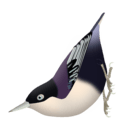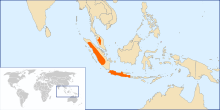Blue nuthatch
| Blue nuthatch | |
|---|---|
 | |
| Blue Nuthatch, Sitta azurea, at Cibodas Botanical Garden, Java, Indonesia | |
| Scientific classification | |
| Kingdom: | Animalia |
| Phylum: | Chordata |
| Class: | Aves |
| Order: | Passeriformes |
| Family: | Sittidae |
| Genus: | Sitta |
| Species: | S. azurea |
| Binomial name | |
| Sitta azurea Lesson, 1830 | |
| Synonyms | |
|
• Callisitta azurea (Lesson, 1830) | |
The blue nuthatch (Sitta azurea) is a bird species in the Sittidae family, collectively known as nuthatches. It is a medium-sized nuthatch, measuring 13.5 cm (5.3 in) in length. The species, which lacks sexual dimorphism, has dramatic coloration unlike any other member of its genus. Its head is black or blackish-blue dark blue upper parts close to purple with azure feathers. The wings are edged with black. The throat and chest are white or a washed buff color, contrasting with the upper and the belly of a very dark blue; the feathers are generally clear, blue-gray or purplish.
The blue nuthatch is found in the Malay Peninsula and in Indonesia, on the islands of Sumatra and Java, inhabiting subtropical or tropical moist lowland forests and subtropical or tropical moist montane forests above 900 m (3,000 ft) in altitude. Its ecology is poorly known, but it feeds on small invertebrates found on trees; reproduction takes place from April to June or July.
Three subspecies are distinguished: S. a. expectata, S. a. nigriventer and S. a. azurea, which vary chiefly in the coloring of their mantles, chests and bellies. The species' apparent closest relatives are the velvet-fronted nuthatch (S. frontalis), the yellow-billed nuthatch (S. solangiae) and the sulphur-billed nuthatch (S. oenochlamys). The population of the species has not been rigorously estimated but the species appears to be at low risk of extinction because of the extent of its distribution. It has been classified as of Least Concern by the International Union for Conservation of Nature.
Taxonomy
The nuthatches constitute a genus – Sitta – of small passerine birds belonging to the family Sittidae,[2] typified by short, compressed wings and short, square 12-feathered tails, a compact body, longish pointed bills, strong toes with long claws, and behaviorally, by their unique head-first manner of descending tree trunks. Most nuthatches have gray or bluish upperparts and a black eyestripe.[3][4] Sitta is derived from the Ancient Greek name for nuthatches, σίττη, sittē.[5][6] "Nuthatch", first recorded in 1350, is derived from "nut" and a word probably related to "hack", since these birds hack at nuts they have wedged into crevices.[7] The genus may be further divided into seven subgenera,[fn. 1] of which the blue nuthatch is placed alone in Poecilositta (Buturlin 1916).[8]
The blue nuthatch was first described in 1830 under its current binomial name, Sitta azurea, by the French naturalist René Primevère Lesson (1794–1849).[9][10] In 2006, ornithologist Edward C. Dickinson proposed a revision of the nuthatch genus, in which certain species would be split off into separate genera, based on distinct morphological traits. He suggested as candidates the velvet-fronted nuthatch (Sitta frontalis) and the blue nuthatch, the morphology of which he describes as "rather aberrant ... in spite of a character trait (white edges to wing feathers) shared with Sitta formosa", and that doing so might, in turn, require S. Formosa (the beautiful nuthatch) to be split off as well. He stated, however, that a molecular study would be warranted prior to any re-classification.[11]
Nuthatch phylogenic detail according to Pasquet, et al. (2014):[4]
- Weakly-supported clade
-
-
- Brown-headed nuthatch (S. pusilla)
- Pygmy nuthatch (S. pygmaea)
- canadensis group
-
-
- Blue nuthatch (S. azurea)
-
- Velvet-fronted nuthatch (S. frontalis)
- Sulphur-billed nuthatch (S. oenochlamys)
-
In 2014, Eric Pasquet, et al. published a phylogeny based on examination of nuclear and mitochondrial DNA of 21 nuthatch species.[fn. 2] The position of the blue nuthatch within the genus was not established with certainty, having a far lower statistical association than many others in the model. Nevertheless, under the findings the species appears best represented by a clade comprising the velvet-fronted nuthatch and the sulphur-billed nuthatch (S. oenochlamys), and probably the yellow-billed nuthatch (S. solangiae), despite not being in the study's sample group. These tropical Asian nuthatches are themselves a sister clade to one comprising the subgenus Sitta (Micrositta) (sometimes called the canadensis group), plus the brown-headed nuthatch (S. pusilla) and the pygmy nuthatch (S. pygmaea).
The blue nuthatch has three recognized subspecies:[12]
- S. a. expectata (Hartert, 1914), described in 1914 by German ornithologist Ernst Hartert as Callisitta azurea expectata from a holotype taken in the Malay Peninsula's Semangko Pass in Pahang;[13] it is also found in Sumatra;[14]
- S. a. nigriventer (Robinson & Kloss, 1919), described in 1919 by British zoologists Herbert Christopher Robinson and Cecil Boden Kloss as Poliositta azurea nigriventer from a holotype taken at Mount Gede[15] in West Java, Indonesia.[14] British ornithologist William Swainson had described the subspecies under the name dendrophila flavipes in 1838, but the name was subsequently little used, and can be considered a nomen oblitum ("forgotten name");[16]
- S. a. azurea (Lesson, 1830), the nominate subspecies, was described in 1830 by René-Primevère Lesson[9] from a specimen possibly taken on the Arjuno-Welirang stratovolcano; inhabits central and eastern Java.[14]
Description
The appearance of the blue nuthatch differs significantly from all other nuthatches. The three taxa of the species, nominate S. Azurra and two other subspecies, vary predominantly in the coloring of their mantles, chests and bellies. All are broadly black and white[17] – especially when viewed in low light conditions in which their dark blue coloring is not apparent – but their upper plumage is shot through with dramatic notes of cobalt, azure and other lighter shades of blue, as well as grays and purples. The head is black, or blackish-blue with a broad, pale blue eye ring.[18][19]
The upper parts are dark blue at the mantle or purplish in some subspecies. The retrices (flight feathers) are pale blue in the middle, with a black border and contrast sharply with the dark areas of the coat. The throat and breast are white, or washed buff, especially in subspecies S. a. nigriventer. The belly and abdomen are blackish, contrasting with blue-gray or purplish coverts. The bill is lavender, slightly tinged with green, and black at the tip; the legs are a pale blue-gray and the claws are slate or black.[18][19]
There is no significant sexual dimorphism, but Japanese ornithologist Nagamichi Kuroda describes the female as having slightly duller upper parts. Juveniles are similar to adults, but with the crown and ear coverts duller, and having a brown cast. The belly is a dull black and the undertail coverts are variably edged a creamy white. The juvenile's bill is blackish, with a pink base. Adults experience a partial moult before the breeding season (February–March for S. expectata; March–April for S. azurea) involving the throat, chest and mantle; a complete moult takes place after the breeding season (March–April and August in Java in Malaysia).[18]
The species is of medium size compared with other nuthatches, measuring 13.5 cm (5.3 in) in length. The folded wing measures 75–83 mm (3.0–3.3 in) in males and 75–85 mm (3.0–3.3 in) in females. The tail is 41–45 mm (1.6–1.8 in) in males and from 39.5 mm (1.56 in) to 46 mm (1.8 in) in females. The beak measures from 16.1–17.6 mm (0.63–0.69 in) in length, and the tarsus 15–18 mm (0.59–0.71 in). The weight is not known,[20] but may be comparable to the Algerian nuthatch (Sitta ledanti), which also measures 13.5 cm (5.3 in) long, and weighs between 16.6 g (0.59 oz) and 18 g (0.63 oz).[21]
The only nuthatch sharing its range is the velvet-fronted nuthatch, which completely covers the distribution of the blue nuthatch, but these two species are not easily confused.
- The three subspecies of the blue nuthatch and their distinct morphological characteristics
 Sitta azurea expectata - note the dark blue upper parts and azure coverts.
Sitta azurea expectata - note the dark blue upper parts and azure coverts. Sitta azurea azurea - note the purple upper parts and violet coverts.
Sitta azurea azurea - note the purple upper parts and violet coverts. Sitta azurea nigriventer - note the purplish-blue upper parts, blue coverts and buff colored belly.
Sitta azurea nigriventer - note the purplish-blue upper parts, blue coverts and buff colored belly.
Ecology and behavior
Voice
The vocal repertoire of the blue nuthatch is quite varied and is reminiscent of the velvet-fronted nuthatch and, to a lesser extent, the sulphur-billed nuthatch. According to the Handbook of the Birds of the World, blue nuthatch vocalizations include: "a mellow "tup" or "tip", an abrupt "whit", a thin sibilant "sit" and a fuller, harder and more emphatic "chit"; in excitement "sit" and "chit" notes [are] often given in short rapid repetitions, "chi-chit, chit-chit-chit" or "chir-ri-rit", which can be extended into [a] fast series, accelerating into staccato trilling "tititititititik", or even become a winding rattle, "tr-r-r-r-r-r-t". Also thin, squeaking "zhe" and "zhe-zhe", and nasal "snieu" or "kneu" (like the sound of squeaky toy); [the] flight call [is] a buzzy "chirr-u"."[3]
Feeding
The blue nuthatch is very active, often seen running in pairs,[22] in larger groups, or mingling in mixed-species foraging flocks.[23] It feeds on invertebrates, of which some have been particularly identified as common in its diet, including species of Trachypholis Zopheridae beetles, typical click beetle (of the Elateridae family), leaf beetles (in the subfamily Eumolpinae) and spiders and moth caterpillars.[24] It typically forages for prey in the upper half of large trees, and occasionally in smaller trees.[23] While prospecting on tree trunks, the bird protects its corneas from falling bark and other debris by contracting the bare skin around its eyes – an adaptation apparently unique to the species.[25]
Breeding
Reproduction in the species has not been extensively studied. The nest is made in a small tree hole in which it lays three to four dirty-white eggs, washed in lavender and densely speckled with reddish-brown and gray, that measure 19.3 mm × 13.4 mm (0.76 in × 0.53 in). In Peninsular Malaysia, juveniles just reaching maturity were observed in late June; on the island of Java, the breeding season takes place from April to July, and on Sumatra an adult feeding its young was observed on May 9.[23]
Predation
Little has been specifically reported on blue nuthatch predators, but one individual was seen to freeze during the passage of a prospecting black eagle (Ictinaetus malayensis).[22]
Distribution and habitat

This species lives in the Malay Peninsula (in extreme southern Thailand and northern Malaysia) and in Indonesia on the islands of Sumatra and Java.[1][14] In Malaysia, the species has been observed in Bukit Larut, in the state of Perak, in the Titiwangsa Mountains, in southern Hulu Langat, in the state of Selangor, as well as some isolated populations on the slopes of the massive Mount Benom in the state of Pahang, on Mount Tahan located at the Pahang-Kelantan border, on mount Rabong in Kelantan and at Mount Padang in the Sultanate of Terengganu.[23]
In Sumatra, the bird is found throughout the Barisan Mountains, and has been observed in the Gayo Highlands of Aceh province, the Batak Highlands of northern Sumata, and at Dempo in the south of the island.[23] In a 1918 expedition by Robinson and Kloss, they commented: "from the commencement of heavy jungle on the valley slopes up to about 8,000 feet on Korinchi Peak this strikingly coloured little Nuthatch was very common, feeding on tall tree trunks in parties of six or seven."[26]
The blue nuthatch is typically found on mountains, inhabiting subtropical or tropical moist lowland forests and subtropical or tropical moist montane forests. In Malaysia, it is found from 1,070 m (3,510 ft) to the highest point in the country at 2,186 m (7,172 ft). In Sumatra, the species has been reported at an altitudinal range of between 900 m (3,000 ft)[23] and 2,400 m (7,900 ft),[23] and on Java, between 915 m (3,002 ft) and 2,745 m (9,006 ft). Ornithologist John MacKinnon has reported some rare sighting at lower altitudes on the plains of Java.
Threats and protection
The blue nuthatch is a common bird in Sumatra, including in the area of Kerinci Seblat National Park[26] and relatively common in Malaysia and Java.[23] It has a very wide distribution area, approaching 361,000 km2 (139,000 sq mi).[27] The population has not been rigorously estimated but is considered significant and at low risk, despite BirdLife International's observation that some decline is likely (but not as yet confirmed) due to known destruction and fragmentation of areas the species is known to inhabit.[27] The blue nuthatch is placed in the category of Least Concern by the International Union for Conservation of Nature.[1]
Footnotes
- ^ Being Callisitta, Poecilositta, Oenositta, Sitta, Mesositta, Micrositta and Leptositta.[8]
- ^ The 21 species are out of 24 recognized as making up the genus by Harrap and Quinn as of 1996. Of these, the study omitted the Indian nuthatch (Sitta castanea), the yellow-billed nuthatch (Sitta solangiae) and the white-browed nuthatch (Sitta victoriae). The International Ornithological Congress however recognized 28 species as of 2012, based on the elevation of four taxa from subspecies to full species status, including Przevalski's nuthatch (S. przewalskii) and three species from the europaea group.[4]
Citations
- 1 2 3 BirdLife International (2012). "Sitta azurea". IUCN Red List of Threatened Species. Version 2013.2. International Union for Conservation of Nature. Retrieved May 13, 2014.
- ↑ Sibley, David; Elphick, Chris; Dunning, John Barnard (2001). Sibley guide to bird life and behavior. Alfred A. Knopf. p. 434. ISBN 978-0-679-45123-5.
- 1 2 Hoyo, Josep del; Elliott, Andrew; Christie, David A. (2008). "Sittidae (Nuthatches): Systematics". Handbook of the Birds of the World: Penduline-tits to Shrikes. 13. Lynx Edicions (HBW Alive for online version).
- 1 2 3 Pasquet, Eric; Barker, F. Keith; Martens, Jochen; Tillier, Annie; Cruaud, Corinne; Cibois, Alice (April 2014). "Evolution within the nuthatches (Sittidae: Aves, Passeriformes): molecular phylogeny, biogeography, and ecological perspectives". Journal of Ornithology. doi:10.1007/s10336-014-1063-7.
- ↑ Jobling, James A. (2010). The Helm Dictionary of Scientific Bird Names. Christopher Helm. p. 357. ISBN 978-1-4081-2501-4.
- ↑ Matthysen 2010, p. 4.
- ↑ " Entry for 'Nuthatch' ". Oxford English Dictionary. Oxford University Press. Retrieved April 17, 2014. (Subscription required (help)).
- 1 2 Matthysen 2010, p. 269–270.
- 1 2 Lesson, René Primevère (1831). Traité d'ornithologie, ou, Tableau méthodique des ordres, sous-ordres, familles, tribus, genres, sous-genres et races d'oiseaux (in French). F. G. Levrault. p. 316. OCLC 768399957.
- ↑ Fischer, Dan L. (2001). "French Traders, 1827–1828". Early Southwest Ornithologists, 1528–1900. University of Arizona Press. p. 18. ISBN 0-8165-2149-2.
- ↑ Dickinson, Edward C. (2006). "Systematic notes on Asian birds. 62. A preliminary review of the Sittidae". Zoologische Verhandelingen, Leiden. Rijksmuseum. 80 (5): 225–240. ISSN 0024-0672.
- ↑ Peterson, Alan P. (August 21, 2016). "Entry for Sitta azurea in Zoonomen – Zoological Nomenclature Resource". Version 1.018. Passeriformes: Sittidae Lesson 1828 – Listing with subspecies. Archived from the original on January 7, 2017.
- ↑ Hartert, Ernst (1914). "Callisitta azurea expectata". Bulletin of the British Ornithologists' Club. British Ornithologists' Club. Vol. 35: p. 34. OCLC 761190665.
- 1 2 3 4 "Nuthatches, Wallcreeper, treecreepers, mockingbirds, starlings & oxpeckers". Version 6.4. International Ornithological Congress (IOC) World Bird List. October 22, 2016. Family Sittidae. Archived from the original on January 7, 2017.
- ↑ Robinson, Herbert Christopher; Kloss, Cecil Boden (1919). "New subspecies of Malay birds: Poliositta azurea nigiventer". Bulletin of the British Ornithologists' Club. British Ornithologists' Club. Vol. XL: p. 17.
- ↑ Dickinson, E. C.; Loskot, V. M.; Morioka, H.; Somadikarta, S.; van den Elzen, R. (December 2006). "Systematic notes on Asian birds. 66. Types of the Sittidae and Certhiidae". Zoologische Verhandelingen, Leiden. 80 (18): 287–310. OCLC 700480502.
- ↑ Harrap 1996, pp. 48–49.
- 1 2 3 Harrap 1996, pp. 168–169.
- 1 2 Harris, Tim (ed.). "Nuthatches and Wallcreeper". National Geographic Complete Birds of the World. National Geographic. p. 307. ISBN 978-1-4262-0403-6.
- ↑ Harrap 1996, p. 169.
- ↑ Harrap 1996, pp. 135–138.
- 1 2 Wells, David R. (2007). "Passerines". In Christopher Helm. The Birds of the Thai-Malay Peninsula. 2. pp. 431–432. ISBN 978-0-7136-6534-5.
- 1 2 3 4 5 6 7 8 Harrap 1996, p. 168.
- ↑ Becking, J. H. (1989). "Diets of Javanese birds". In Brill Archive. Henri Jacob Victor Sody (1892-1959): His Life and Work: a Biographical and Bibliographical Study. p. 209.
- ↑ Curio, Eberhard (2001). "Wie Vögel ihr Auge schützen: Zur Arbeitsteilung von Oberlid, Unterlid und Nickhaut". Journal für Ornithologie (in German). 142. doi:10.1007/BF01651365.
- 1 2 Robinson, Herbert Christopher; Kloss, Cecil Boden (1918). "Results of an expedition to Korinchi Peak, 12,400 ft., Sumatra. – Pt. II: Birds". Journal of the Federated Malay States Museums. Kelly & Walsh. Vol. VIII: 229. OCLC 15726954.
- 1 2 Ekstrom, Jonathan; Butchart, Stuart. "Blue Nuthatch - BirdLife Species Factsheet". BirdLife International. Retrieved May 12, 2014.
Bibliography
External links
| Wikimedia Commons has media related to Sitta azurea. |
| Wikispecies has information related to: Sitta azurea |
